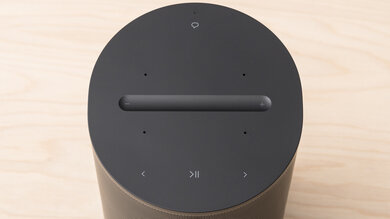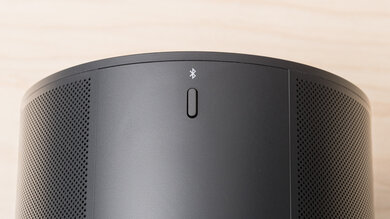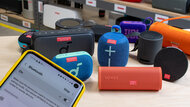The Sonos Era 100 is a premium home speaker released in 2023. It has a wide array of built-in smart features to make the most of your listening experience. Alexa support lets you control the device with only your voice, and through the Sonos S2 app, you can connect it with compatible Sonos speakers to spread audio throughout your home. Alongside the larger and more premium Sonos Era 300, it's one of the few Sonos speakers to include Bluetooth connectivity. It doesn't have Dolby Atmos support like the 300, so you can't enjoy more premium audio formats like with Dolby Atmos Music.
Our Verdict
The Sonos Era 100 is good for listening to music. The speaker has some features to adjust its output based on your room's acoustics, as with most premium speakers on the market. Its balanced mid-range makes it suitable for listening to many different music genres. Since it's a stereo speaker, it has a wider sound than mono-only models like the Sonos One SL, with better instrument separation in the soundstage. Given its bass and treble adjustments, you have some ability to customize its performance, too.
-
Room correction tools.
-
Bass and treble adjustments.
-
Not quite loud enough for larger rooms.
-
Some compression at max volume.
The Sonos Era 100 is fair for watching videos and movies. It supports Wi-Fi and Apple AirPlay 2 connectivity, as well as Bluetooth for easy streaming from your mobile devices. You can even purchase a separate Line-In Adapter to pair it with a computer or other audio sources or use the Sonos S2 app to connect it with your soundbar for a more robust home theater setup. Dialogue reproduces with clarity, and there's a fair amount of rumble in the bass during action-packed scenes.
-
Bass and treble adjustments.
-
Bluetooth and Wi-Fi compatible.
-
Not quite loud enough for larger rooms.
-
Some compression at max volume.
The Sonos Era 100 is decent for podcasts. Voices are clear and detailed out of the box, meaning you can easily follow along with your favorite shows. Bass and treble adjustments let you customize the sound, too, meaning you can get an even cleaner output. If you own other compatible Sonos products, you can set them up in the app to amplify your show across your house or move the audio from one room to the next as you walk through the house. However, this speaker isn't designed with portability in mind, given that it's wired only.
-
Bass and treble adjustments.
-
Bluetooth and Wi-Fi compatible.
-
Not quite loud enough for larger rooms.
-
Some compression at max volume.
The Sonos Era 100 is excellent for voice assistants. Built-in Alexa lets you control the speaker using only your voice, and it can understand your commands, even if you're far away. The microphone mute feature is also a great option for more private moments. If you're an Apple Music user, you can even set up Siri through the Apple Home app, though it's limited to music selection. It performs well but can struggle to hear your voice in noisier environments.
-
Room correction tools.
-
Microphone mute available.
-
Not quite loud enough for larger rooms.
The Sonos Era 100 is a wired-only speaker that's not intended for outdoor use.
- 7.6 Music
- 6.9 Videos/Movies
- 7.3 Podcasts
- 8.8 Voice Assistant
- 5.6 Outdoors
Changelog
-
Updated Nov 21, 2024:
Sonos recently updated their app to firmware 81.1-58210 and the speaker itself to firmware 15.2. As a result, this speaker's Sound profile changed. The following test groups have been updated: Frequency Response Accuracy, Soundstage, Dynamics, and App. Text changes have also been made throughout the review, including the usages and product comparisons, to match these results.
- Updated Apr 12, 2024: We've updated this review's text to keep it up to date and accurate.
- Updated Jan 22, 2024: Updated the Microphone On/Off result in the Controls box from 'No' to 'Yes'.
- Updated Nov 27, 2023: Added market comparison with the JBL Authentics 200 in the Wi-Fi box.
- Updated Nov 21, 2023: Changed the USB Audio results in Wired from "Yes" to "No". While the speaker comes with a USB-C port, it can only receive audio through a line-in adapter sold separately.
Check Price
Differences Between Sizes And Variants
The Sonos Era 100 is available in both Black and White color variants. We tested the Black version; you can see the label for the model we tested here. That said, since the only difference between the two variants is the color, we expect them to perform similarly.
If you encounter another version of this speaker, let us know in the forums, and we'll update our review.
Compared To Other Speakers
The Sonos Era 100 is a more affordable alternative to the Sonos Era 300. It's smaller and more compact, and while it doesn't support Dolby Atmos, it has easy integration with compatible Sonos soundbars. This speaker offers a cleaner and more balanced sound compared to the Sonos One Gen 2/One SL, with additional features like Bluetooth connectivity. If you already own products in the Sonos ecosystem, you'll appreciate that you can connect this speaker to other devices. While it's versatile, it does come at a slightly more premium cost than other smart speakers on the market.
You can also check out our recommendations for the best smart speakers, the best home speakers, and the best sounding Bluetooth speakers.
The Sonos Era 100 and the Sonos Move 2 are very comparable speakers in terms of performance and sound reproduction. The main difference is that the Era 100 is cheaper but doesn't have a built-in battery, so you can't easily take it on the move. It's also not rated for dust or water resistance like the Move 2. So if you want to bring your speaker on the go, the Move 2 is the better choice.
The Sonos Era 100 is better than the Sonos One Gen 2/One SL. While they're both premium speakers designed for home use, the Era 100 has slightly better sound quality. The bass doesn't leak into the mids quite as much, resulting in a cleaner sound. But both speakers have a healthy boost in the high-bass region, adding warmth to basslines. Plus, unlike the One Gen 2, the Era 100 can playback stereo content without downmixing it into mono. Additional features are available, including Bluetooth connectivity and a Quick Tuning feature for Android users.
The Sonos Era 300 is better than the Sonos Era 100. The 300 is a larger speaker with additional features, including Dolby Atmos support, which is great if you want to listen to Dolby Atmos music. On a smaller note, its voice assistant performs a touch better in noisy environments, which may or may not be important to you.
The Sonos Move is more versatile than the Sonos Era 100. As its name implies, the Move is built with portability in mind, and since it's battery-powered, you can take it on the go with more ease than the wired-only Era 100. It's even rated for dust and water resistance in case you run into the elements, which the home-only Era 100 doesn't require. Both speakers support Bluetooth, and they both have built-in voice assistants. However, only the Era 100 supports stereo audio, resulting in a wider sound with better instrument separation between the right and left drivers.
The Apple HomePod (2nd generation) and the Sonos Era 100 are both very premium smart speakers, and depending on your listening habits, you may prefer one over the other. First, if you already own products in either the Apple or Sonos ecosystem, you'll find it's easier to integrate them with their respective speaker. For example, the Sonos speaker is designed to work with Sonos soundbars. Also, the Sonos is more customizable, with bass and treble adjustments on hand, and it supports Bluetooth, unlike the Apple speaker. However, the Apple can reproduce a better low-frequency extension, so you feel more thump and rumble in your audio.
The Sonos Era 100 is a better all-around speaker than the Amazon Echo Studio. While they're both wired speakers with similar build qualities, the Sonos has better directivity, meaning it sounds more consistent across all listening angles. It's also compatible with Apple Airplay and has a more intuitive control scheme. That said, the Amazon has less compression present at maximum volume than the Sonos.
The Sonos Era 100 is a better speaker than the JBL Authentics 200. They're both wired-only home speakers with built-in voice assistant support. However, the Sonos has a more balanced sound out of the box, which some users may prefer. It also has a 360-degree design for a better soundstage performance. That said, some may prefer the JBL's retro design.
The Bose Home Speaker 500 and the Sonos Era 100 are similar wired speakers designed for use at home. They're both well-built and feature both Wi-Fi and Bluetooth compatibility; however, the Bose has the edge in a few key areas. It has better voice assistant integration, with built-in Google Assistant capabilities, and it does a better job of picking up your voice commands. It also has lower AV synchronization error with Android and iOS devices, so it's better for watching movies and videos. However, the Sonos has a slightly more balanced mid-range with a room correction feature that tunes its sound profile to the acoustics of your room.
Test Results
The Sonos Era 100 is a sleek home speaker available in Black and White color variants. It has a cylindrical design similar to that of the Sonos One SL. It's smaller than the Sonos Era 300, too, so it takes up less space in your living area. The cable is long and thick, and it connects underneath the speaker for a more discreet look. Plus, there's a threaded mounting hole if you want to place it on a tripod or the separately available Era 100 Stand.
This speaker is pretty small and lightweight. However, since it's wired-only, it's not the best choice if you want to bring your music with you on the go. If you're moving it from room to room, it's easy enough to carry in one hand.
The Sonos Era 100 has a solid and sturdy build for surviving the everyday bustle of your household. It's mostly made of plastic. Even the grilles in front are made of plastic, unlike the metal grilles you find with the Sonos One SL. Since it's meant for indoor use, it isn't rated for dust and water resistance. That said, if you want to use it near your shower or sink, the manufacturer does say that it can withstand high humidity.
The controls are located on the top of the speaker. They're quite easy to use, and they offer some feedback. For example, the green light on the Sonos logo stays solid when you reach the lowest volume setting. There's an audible cue for min and max volume as well. Also, a light on top of the speaker lets you know when voice services are enabled. You get an audible chime, and a blue light appears when you pair and connect to a device.
- Press or swipe across +/- buttons: Controls the volume.
- Press once: Plays/pauses audio.
- Press and hold play/pause button: Adds audio that's playing in another room.
- Press Fast Forward button: Skips to the next track.
- Press Rewind button: Skips to the previous track.
- Press Voice Services button: Enables/disables voice control.
- Press and hold Bluetooth button: Pairs a new device.
- Press Bluetooth button once: Connects to a previously recognized device.
There's also a microphone on/off switch on the rear of the speaker. When the microphone is off, all features that use the device are disabled, including voice services and the Trueplay tuning.
The Sonos Era 100 has a decent frequency response accuracy. As with the Sonos Era 300, it has two room correction options—iOS users can opt for Advanced Tuning, while Android users are limited to the Quick Tuning tool. The difference is that Quick Tuning only uses the microphones in the speaker, while the Advanced Tuning feature also runs microphones through your phone to adjust the speaker's sound. For our testing, we ran the Advanced Tuning tool.
It has a generally balanced sound that trends slightly warm. It's not a huge speaker, so it can't reproduce thumpy low-bass, but there's just the right amount of mid-bass punch to keep kick drums feeling exciting. A small boost in the high bass adds warmth to basslines. The mids are almost flat, so voices and lead instruments are reproduced accurately and without any honk or harshness. It's a slightly cleaner sound than you get with the Sonos One Gen 2/One SL, with a bit less bass bleeding into the vocals, though some listeners may still find vocals a bit too muddy. Still, in songs like Billie Eilish's Bad Guy, her soft vocals are clear and present even with the prominent bassline. Plus, since this is a stereo speaker, the overall sound is wider than you get with the One Gen 2/One SL. The low treble is a little recessed, which can make music and voices sound smoother, but some may find it makes drums duller than they'd like. Fortunately, you can always use the bass and treble adjustments to customize its sound.
The soundstage performance is excellent. It's a stereo speaker, so you don't need a second model to get stereo sound. Plus, its 360-degree design provides a wide and immersive sound, and you get good separation of instruments between the right and left channels. Its directivity is very good, too, so your audio sounds consistent from different angles.
This speaker gets loud. It'll easily fill an average-sized living room and will likely get loud enough for a larger space like a loft or garage. There's some compression at max volume, just like with the Sonos One Gen 2/One SL. That impacts the clarity of audio reproduction, but it only affects bass frequencies, which aren't especially prominent in a speaker of this size.
Thanks to built-in Alexa, you can enjoy a fantastic voice assistant performance with this speaker. It has no trouble hearing your commands, even if you're further away. It doesn't perform as well as the Sonos Era 300 in noisier environments, but if you have the Apple Home app, you can set it up to ask Siri to play audio through Apple Music. You can't use Siri for other voice assistant functions, though.
The Sonos S2 app is a handy tool, if a little clunky to use. It lets you control the speaker from your phone or another mobile device. You can adjust Trueplay tuning and tweak the bass and treble amounts using the app. Advanced Tuning with Trueplay is only available with iOS devices, while Android users are limited to Quick Tuning. You can also check out the Loudness tool if you like to listen at lower volumes. Your ear can struggle to pick up bass range frequencies when the volume is low; this feature is designed to compensate for that by boosting these frequencies. You can also connect the speaker with other compatible Sonos devices through the app and set up a stereo pair with them for a more immersive sound. For a full tour, you can check out our video here.
This speaker has a USB-C port. It's designed for both audio playback and Ethernet connections, though you must purchase Sonos' compatible Line-In Adapter or Combo Adapter separately to connect your devices.
Unlike previous Sonos speakers, this device supports Bluetooth connectivity. You're able to stream audio from your phone to the speaker wirelessly. Though we measured a fair amount of audiovisual synchronization error, especially with Android, we didn't notice much delay when watching real-life content. Some apps, like YouTube, compensate for this, though, which may explain part of the difference. Depending on the status of their servers, the latency could vary.
This speaker is Wi-Fi compatible, making streaming audio over your home network easy. If you own an Apple device, you can stream to the speaker using Apple AirPlay 2. Check out a home speaker like the JBL Authentics 200 if you want something with Chromecast support.
Comments
Sonos Era 100: Main Discussion
Let us know why you want us to review the product here, or encourage others to vote for this product.
Update: We uploaded the latest brightness measurements and uniformity photos for the Accelerated Longevity Test.
- 21010
I would like to let know who ever stumbles upon it, the latest firmware released 6.25.2024 seems to finally fix the broken input lag! Game mode works properly again! 19ms game mode 36ms game mode + 60hz strobe ~95ms outside game mode
Update: We uploaded the latest brightness measurements and uniformity photos for the Accelerated Longevity Test.
- 21010
Ok after doing a factory reset, the numbers actually did improve. But not to the same level as in Android 9 and your own review. Instead of an 18ms baseline it’s now ~34ms baseline in game mode. Enabling Motionflow at all (Even at 1/1) adds 8ms more which it didn’t before, and adding 60hz strobing now adds another 10ms on top of that. So with 60hz strobing it’s a whopping 51ms which is still unacceptably high.
Writing back in case any other users are looking for the info. Not long after the factory reset, the input lag in Game Mode returns to a 69+ms baseline. (As is the baseline outside of game mode).
A factory reset does not improve it enough. I’ve ordered a replacement main board in hopes it has the old firmware on it so we can verify the issue is firmware related.


































